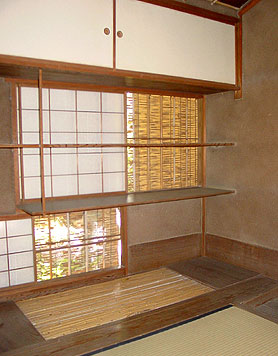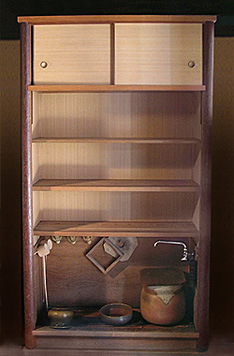|
||
 |
||
An area adjacent to a tea ceremony room *chashitsu 茶室 used to make preparations for performing the tea ceremony. It corresponds to a kitchen in a residence. Mizuya are usually either 2 or 4 1/2 *tatami 畳 mats in size. The contents of the mizuya are as follows: storage shelves of varying types, a cupboard, sink misara 水皿 and drain covered by a slatted drainboard, nagashisunoko 流し簀子, and pegs for hanging cloths. Sometimes either a large rectangular firebox *dairo 大炉 or a relatively small cylindrical one *ganro 丸炉 is provided for boiling water when preparing meals to be served in the tea ceremony room. Everything needed for preparation and serving the tea ceremony has a designated place on the shelves or in the cupboard. Charcoal is also stored in the mizuya. The various tools found in the mizuya are called mizuya gatte 水屋勝手. It is not clear when the mizuya per se was created. The *CHADOU SENTEI 茶道筌蹄 (1816) says that originally there were no mizuya but instead, preparation for the tea ceremony was performed on the veranda. It also states that the first use of mizuya is to be found at Fushin'an 不審庵, Kyoto, in a 3-mat daime room. See *daimedatami 台目畳. The room now has one long shelf attached to the wall at each end, a drop shelf suspended beneath it, and double hanging shelves *nijuudana 二重棚 above it. There is no doubt that mizuya existed in the Momoyama period. The mizuya is mentioned in anecdotes concerning its use by Takeno Jouou 武野紹鴎 (1502-55) and Sen Rikyuu千利休 (1522-91). Furthermore, many tea ceremony rooms extant from the end of the 16c have mizuya. Measurements for mizuya and their various features are not uniform but differ according to period and school. Only a general average can be given based on a number of styles such as Senke 千家, Enshuu 遠州, Fumai 不昧, Yabunouchi 薮内, Sansai 三斎, Souhen 宗偏, and others. These are about 161cm in height, 145cm wide, 55cm deep; the panel on lower part of wall about 33cm high, bottom shelf about 45cm high, middle shelf about 61cm high and square shelf about 79cm high. Where no regular mizuya exists or it is inaccessible, a portable assemblage of tea ceremony utensils, called okimizuya 置水屋, is set in the corner of a hallway for temporary use. Standard measurements are 114cm long, 105cm high and 41cm deep. However, recently many are made the width of a half mat: 84cm x 114cm. Wood of the cinnamon tree is considered best but some are made of cedar.
2 The kitchen of vernacular houses *minka 民家. See *minja みんじゃ.
 |
 |
|
| Meimei'an 明々庵 (Shimane) | okimizuya 置水屋 Nagatomi 永富 house (Hyougo) |
|
(C)2001 Japanese Architecture and Art Net Users System. No reproduction or republication without written permission.
掲載のテキスト・写真・イラストなど、全てのコンテンツの無断複製・転載を禁じます。

